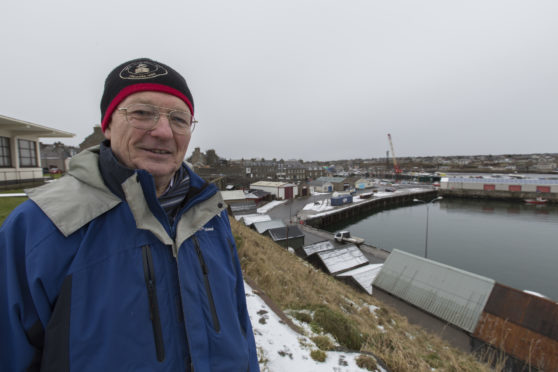A far north town was almost wiped from the map by the Nazis during World War II, a local historian believes.
Wick suffered several air raids by the Luftwaffe, with the most serious taking place on July 1, 1940.
That day, 15 people – including eight children – died when a bomb was dropped on Bank Row.
The tragic losses are still felt in the Caithness town and well-known further afied – but one expert believes the consequences of the already-deadly attack could have been far more devastating for both Wick and the British war effort.
Ammunition ships, loaded with explosives for the Reserve Army, were known to be berthed in the town’s river harbour around the same time.
Harbour records show an 104-tonne munitions ship noted as being present there in May.
Two other boats with links to munitions were recorded in Wick three weeks prior to the tragedy.
Though their presence on the day in question has not been recorded in the official record, local historian Eric Farquhar believes they were there and the intended target.
And he says that the entire town would have been “vapourised” had they been blown up.
The 79-year-old said: “Bank Row was the most unlikely place to be bombed, but it was only 330ft away from where those ships would have been.
“Most of the fishermen in the town knew the real reason behind it was that there were two large ammunition ships, with all the ammunition for the Reserve Army, nearby.
“The Reserve Army was the backup for if Hitler invaded England, and these ships would have moved south to help troops down there.
“So there was a huge amount of ammunition in them, and local fishermen were convinced that is what the Germans wanted to strike.
“What a strategic strike it would have been if there were no ammunition for the Reserve Army – Hitler could have taken his pick for when to invade.
“If the boats had been hit, Wick would been vapourised. There would be no Wick, and they only missed by a few hundred feet.”
Mr Farquhar’s theory emerged during a recording for Wick Voices, an online oral history project run by the Wick Society as a way of preserving the area’s past.
The group’s chairman, Ian Leith, added: “The thought is that the German bomber was so high up it didn’t strike the exact target, that is what has been passed down by sailors.
“I know from personal experience that a lot of the official files were closed in that period, but I have never heard that theory disputed.”
Scotland was bombed 500 times during World War II, with Peterhead the second most targeted location in the UK.
The town was attacked 28 times, while Aberdeen suffered 24 raids.
The last German air raid on a Scottish City occurred in Aberdeen in April 1943, when 29 bomber planes killed 125 people, with the last casualty a farmer’s wife from Fraserburgh.
Victims as young as four, died when a lone German aircraft dropped two bombs on Wick’s Bank Row.
The town came under frequent air attack following the Nazi conquest of Holland and Denmark in 1940.
As German forces occupied Norway, the community became more vulnerable and its RAF base made it a target for the Luftwaffe.
It has been recorded that 222 high explosives were dropped on Caithness, and that Wick was attacked six times.
The first and most serious attack fell on Bank Row, during daytime hours when children were playing outside.
The Junkers 88 aircraft approached from the west, and the resulting blast could be heard from 20 miles away.
It took place more than two months before the London Blitz, and is believed to have been the first daylight air raid on mainland Britain of World War II.
Three others were killed and many injured when enemy planes discharged more than 20 high explosives in and around Hill Avenue, close to the RAF base, just three months later.
In 2010, a memorial garden was created at the Bank Row site in tribute to those who died.










